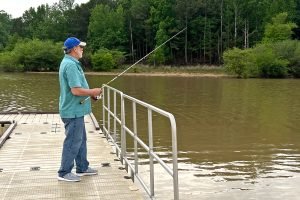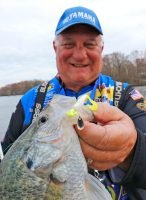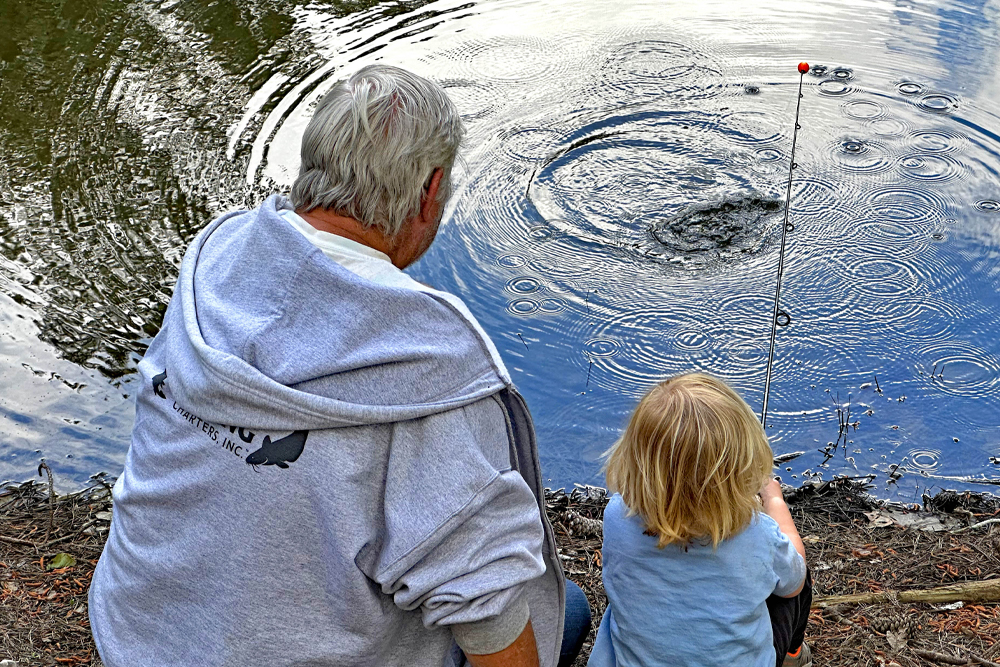CrappieNOW Editor Richard Simms is also a professional fishing guide. He knows all the tricks of the trade.
But when taking his 3-year-old grandson fishing, he knows it is critical to keep it simple. (Photo: Priscilla Simms-Roberson)
Simple Steps to Better Fishing
by Tim Huffman

The purpose of fishing is to have a good time and catch fish. Inexperienced fishermen or complete beginners often struggle. Perhaps they simply don’t know where or how to start buying or preparing equipment. Maybe they miss some of the important steps for being successful. Problems can include breaking your line or just not knowing how to find fish.
Fishing is a learned art so it can take time and work to gain experience and knowledge. The following are a few guidelines and tips; simple steps to better fishing.
Selecting Equipment
Walk into a sporting goods store and the array of rods, reels, tackle, lures and other accessories can be overwhelming. To subscribe to the “KISS” principle (Keep It Simple Stupid), we would suggest a basic 6- or 7-foot spinning rod with a medium-sized reel. In most stores, they offer inexpensive “combos” where the rod & reel are included together. You can spend more or less, but in general expect to pay between $50 and $100 for a decent combo outfit. With the reel spooled with 6-pound or 8-pound test monofilament, this combo is a good starting point for a wide variety of fishing for bluegill, crappie, bass or even catfish. This video from TakeMeFishing.org will provide some additional starter tips.
Things to Do at Home
Once you have your gear, prepare your equipment before you head to the lake or pond. Check your rod and reel to ensure they are in good working order. Add fresh line of proper size, usually 6- or 8-pound test for most situations. Good line will lead to longer casting distance, fewer tangles and a better chance of landing a fish without a broken line.
A tacklebox can become a cluttered mess. It’s important to keep things simple (remember the KISS principle). Be sure to include minnow or worm hooks, split-shot weights, clip-on floats and slip-floats. A few 1/16-ounce Road Runner jigs are good when a fisherman wants to cast artificial baits. Pliers and line clippers are important, too. The less options you have in a tacklebox, the better. Plus, you’ll be able to find everything when all the junk is gone. Think minimalist.
To the Lake

Ask the bait shop operator what the fish are doing. He wants you to catch fish, so you will return to buy more minnows and supplies. Also ask fishermen at the boat ramp if they will share some basic information to get you started.
Confidence baits are important. If you use a bait that you’re not sure will work, you’ll likely change baits often instead of concentrating on presentations. Use a bait that is recommended or has worked for you in the past. Until experienced, there is no better bait than a minnow. It has the look, smell and action to attract a fish without any work by the fisherman. Put it under a float and watch for a bite.
Non-boater. Picking the right spot is important. If fishing from the bank, your options may be limited. Some lakes have plenty of bank access open to the public, but usually much of the land is privately owned or not accessible. When possible, look for areas where the water has cover and depth. Depth allows crappie to be in an area year-round. Shallower water will be best in the spring and fall.
Boaters have more options and opportunities. However, more options can make finding fish a little overwhelming. An important element to learning to fish better is to pick an area of the lake that is known to be good for crappie. For example, a creek usually has a variety of depths drop-offs, bends, sloping banks and plenty of cover. Don’t try to fish the whole lake, pick an area like a creek and learn everything you can about it. Know where fish go during the four seasons, their depths, habits and be sure to build numbers of waypoints of the better structures and cover that will likely lead you to successful fishing in the future.
Pro Comments

Kent Driscoll, Pro Staff Manager for the B’n’M Pole Company, says, “One of the best things a fisherman can do is go old-school fishing with a cork and minnow. It’s very simple and one of my favorite ways to fish. Another thing is to catch what’s biting. For example, white bass are fun to catch and could be running in the area you’re fishing.”
Tournament angler and CrappieNOW Publisher Dan Dannemueller says there are a few things an inexperienced fisherman can do to improve odds of catching fish. The first is to pay attention to weather.
“Check the weather before you plan to go. You don’t want to get out in horrible conditions,” said Dannemueller. “However, if the bad weather is 36 to 48 hours away, fishing should be very good.
“Try to catch fish, but make fishing fun, not a marathon. Fish for two or three of hours, especially when taking the family. If fish aren’t biting, let the kids play. Teach them about the land and water, and respect for the outdoors,” said Dannenmueller.
“Minnows are good, but worms are your friend, too. Maybe not so much for crappie, but for bluegill, catfish, bass and most fish in the water. Anything on the end of the line means more action and more fun.”
Road Runner expert Ron Stallings says, “No one bait always works, but a Road Runner makes fishing an artificial bait as easy as it gets. It works best in water with just a little to moderate tint. The blade gives flash and vibration making it easy to find. I recommend a willow leaf blade that has a great look, sound, flash and vibration. Fish it as slowly as possible, but fast enough to make the blade turn. Put it in the water and see how slowly you can pull it and still have the blade turning. Cast it out, bring it back at the right speed and it will catch anything that swims.”
Fishing doesn’t always mean catching, but that’s okay. Experience will lead to more success. The key is to continue to learn while making the most of each trip. Also take time to enjoy wildlife and all aspects of the outdoors.
CrappieNOW Senior Writer and recent Fresh Water Fishing Hall of Fame member, Tim Huffman, has a new 2024 book, Papermouth, Modern Fishing Techniques, available in Kindle or paperback at Amazon, or link from his website, www.monstercrappie.com


